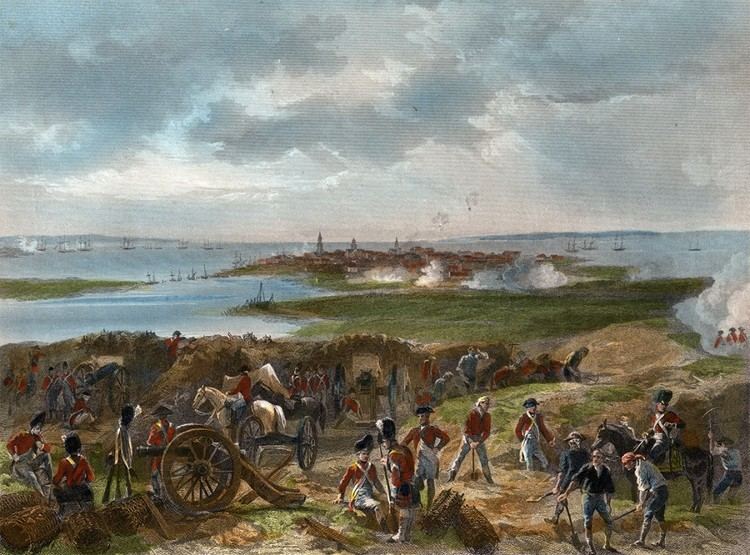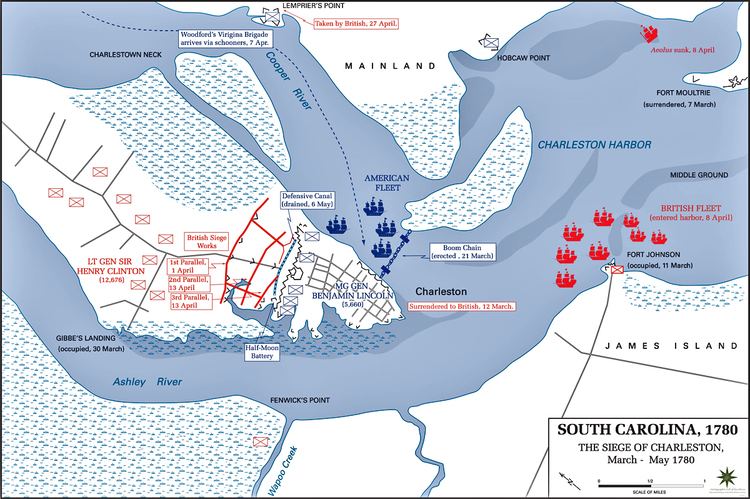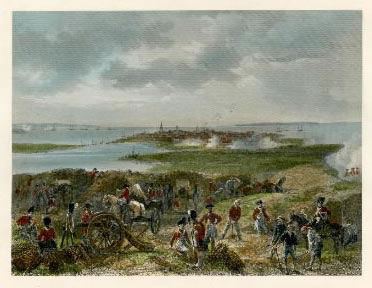Dates 29 Mar 1780 – 12 May 1780 | ||
 | ||
12,847 regulars and militia4,500 sailors6 ships of the line8 frigates4 armed galleys90 transports 6,577 regulars, sailors and militia3 frigates5 sloops1 schooner1 brig3 armed galleys 76 killed,182 wounded 92 killed,148 wounded5266 captured Results British victory, City surrendered to British Similar American Revolutionary War, Battle of Camden, Battle of Cowpens, Battle of Kings Mountain, Southern theater of the Ameri | ||
The Siege of Charleston was a major engagement fought between March 29 to May 12, 1780 during the American Revolutionary War. The British, following the collapse of their northern strategy and their withdrawal from Philadelphia, shifted their focus to the American Southern Colonies.
Contents

After approximately six weeks of siege, Major General Benjamin Lincoln, commanding the Charleston garrison, surrendered his forces to the British, resulting in one of the worst American defeats of the war.

The siege of charleston
Background

By late 1779, two major British strategic efforts had failed. An army invading from Quebec under John Burgoyne, had surrendered to the Americans under Horatio Gates at the Battles of Saratoga, compelling the Kingdom of France to declare war on Great Britain in support of the Americans. Meanwhile, a strategic effort led by Sir William Howe to capture the Revolutionary capital of Philadelphia had met with initial success. Having replaced his superior as Commander-in-Chief of the American Station, Sir Henry Clinton withdrew all his forces back to New York City to reinforce the city against a possible Franco-American attack.

Stymied by the Fabian strategy adopted by George Washington, and, under increasing political pressure to deliver victory, the British turned to launching their "Southern Strategy" for forcing a capitulation of the Americans. The British were persuaded that there was a strong Loyalist sentiment in the south, largely due to the extensive business and trading relationships those colonies had with Britain. It was expected that these Loyalists would rise against the American Patriots in large numbers. The opening British move was the Capture of Savannah, Georgia in December 1778. After repulsing an assault on Savannah by a combined Franco-American force in October 1779, the British planned to capture Charleston, South Carolina, intending to use the city as a base for further operations in the southern colonies.

Sir Henry Clinton evacuated Newport, Rhode Island on October 25, 1779, and left the substantial garrison of New York City under the command of Wilhelm von Knyphausen. In December, he sailed southward with 8,500 troops to join Colonel Mark Prevost at Savannah. Charles Cornwallis accompanied him, and, later, Lord Rawdon rendezvoused with Clinton with an additional force, increasing the size of the expedition to 14 warships, 90 transports and some 16,000 troops.
British forces

The joint British naval-army forces were led overall by Sir Henry Clinton, with his subordinate, Lord Cornwallis as his second-in-command. The British regular troops were led by Brigadier General Alexander Leslie.
The ground and naval forces were composed thus:
Franco-American forces
The Franco-American garrison of Charleston was overall led by Benjamin Lincoln. The Continental Army troops were nominally led by Brigadier General William Moultrie
The ground and naval forces were composed thus:
Siege
Clinton marched upon Charleston via James Island. Cutting the city off from relief, he began a siege of the city on April 1. The following day, the British begun to dig their siege works, approximately 800 yards from the American lines. During these first few days, the British troops were under a heavy artillery fire from the Americans. By April 6, the British fleet had moved into the harbour, under fire from Fort Moultrie. In order to consolidate British control of the immediate area, Clinton dispatched Banastre Tarleton and Patrick Ferguson to capture Monck's Corner, and Lenud's Ferry, scattering American troops and closing American lines of communication into Charleston.
Benjamin Lincoln held a council of war, and was advised by de Laumoy to surrender, with the American situation becoming untenable. On April 21, a parlay was made between Clinton and Lincoln, with Lincoln offering to surrender, should he be granted the honours of war. Clinton refused the terms, and the siege resumed with a heavy artillery exchange. On April 23, Lord Cornwallis crossed the Cooper River, assuming command of the British forces blocking an escape by land. On April 29, the British advanced down the left end of a strategically important canal that fronted Charleston's defences, intending to destroy the dam and drain the canal. The Americans harried the British efforts with stiff resistance, however, by May 6, most of the water had been drained, and the British made plans for an assault on the city.
On the same day, Fort Moultrie surrendered. On May 8, Clinton called for Lincoln's unconditional surrender, but Lincoln again attempted to negotiate for the honours of war. On May 11, the British fired red-hot shot into the city, burning several homes, compelling Lincoln to call for a parlay to negotiate terms for surrender. On May 12, Lincoln, with over 5,000 troops, surrendered to the British. When word reached the back-country, the American troops holding Ninety-Six and Camden also surrendered to the British.
Aftermath
The British captured some 5,266 prisoners, 311 artillery pieces, 9,178 artillery rounds, 5,916 muskets, 33,000 rounds of ammunition, 212 hand grenades, 15 Regimental colours, 49 ships and 120 boats, plus 376 barrels of flour, and large magazines of rum, rice and indigo. Following the surrender, the captured ordnance was brought to a powder magazine. A Hessian officer warned that some of the guns might still be loaded, but he was ignored. One prematurely fired, detonating 180 barrels of powder, further discharging 5,000 muskets in the magazine. The accident killed approximately 200 people and destroyed six houses. The prisoners of the siege were diverted to multiple locations, including prison shops, the old barracks where the College of Charleston is today, and the Old Exchange and Provost "Dungeon".
The defeat was a serious blow to the American cause. It was the largest surrender of an American force under arms, until the 1862 surrender of Union troops at Harper's Ferry during the Antietam Campaign. The surrender left no substantial army in the South, and the colonies were wide open for a British advance. The British troops consolidated their hold, and had driven the remaining Continental Army troops from South Carolina consequent to the May 29 Battle of Waxhaws.
During their surrender the American forces were denied honours of war, leading General George Washington to deny the same to the British during their surrender at the Siege of Yorktown, with Washington saying "The same Honors will be granted to the Surrendering Army as were granted to the Garrison of Charles Town."
On June 5, Clinton sailed back to New York City, believing his presence necessary to defend against a potential Franco-American attack, leaving command of the southern theatre to Lord Cornwallis, with orders to reduce opposition in North Carolina. Though the effects of the surrender at Charleston was substantial, the British err in strategy soon became apparent. There was no popular uprising of Loyalists that the British command had been assured would happen, making control of the countryside difficult. Instead, resistance in South Carolina degenerated into a period of chaotic guerrilla warfare in the outlying areas.
